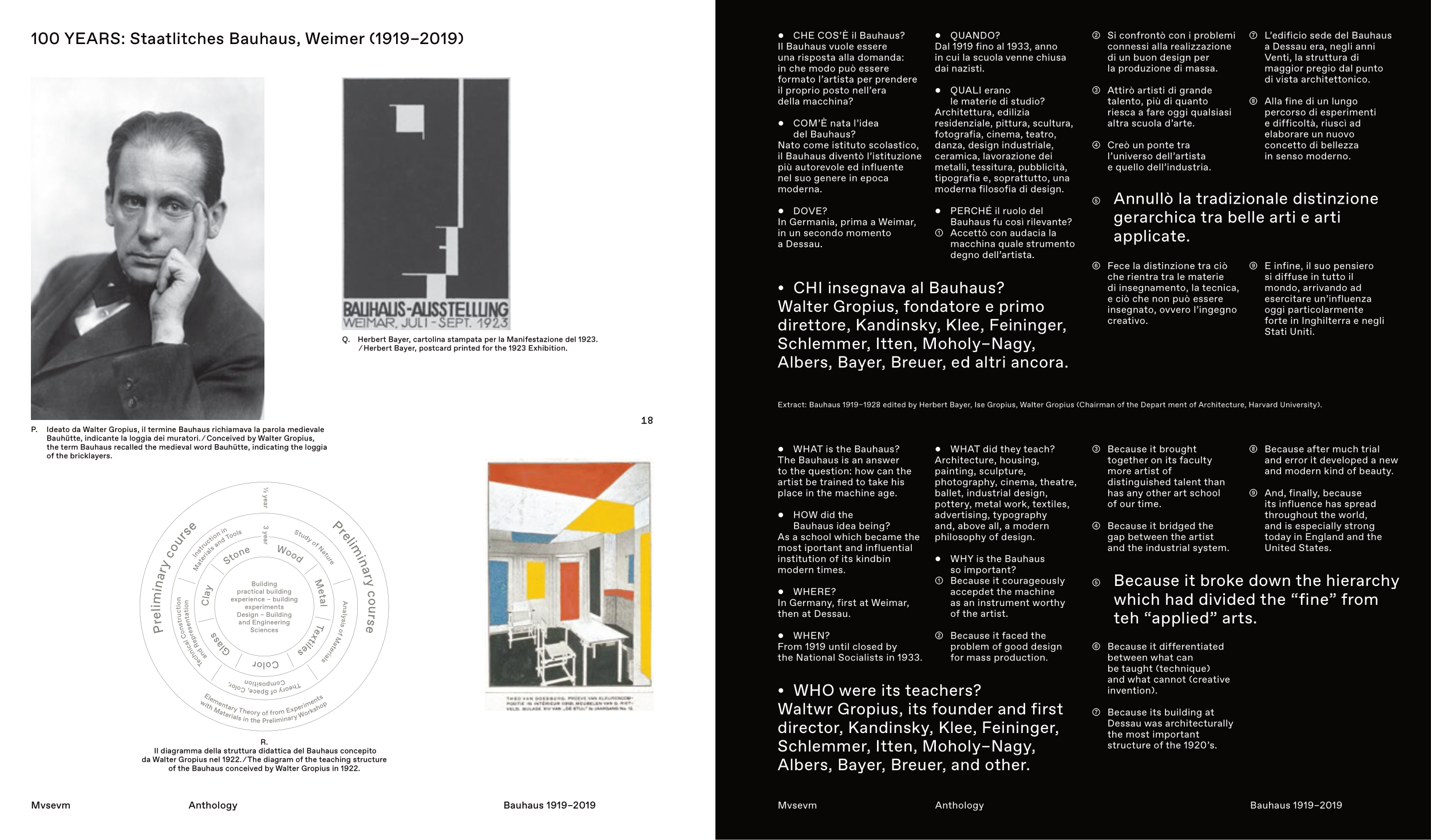18
WHAT is the Bauhaus?
The Bauhaus is an answer
to the question: how can the
artist be trained to take his
place in the machine age.
HOW did the
Bauhaus idea being?
As a school which became the
most iportant and influential
institution of its kindbin
modern times.
WHERE?
In Germany, first at Weimar,
then at Dessau.
WHEN?
From 1919 until closed by
the National Socialists in 1933.
WHAT did they teach?
Architecture, housing,
painting, sculpture,
photography, cinema, theatre,
ballet, industrial design,
pottery, metal work, textiles,
advertising, typography
and, above all, a modern
philosophy of design.
WHY is the Bauhaus
so important?
① Because it courageously
accepdet the machine
as an instrument worthy
of the artist.
② Because it faced the
problem of good design
for mass production.
③ Because it brought
together on its faculty
more artist of
distinguished talent than
has any other art school
of our time.
④ Because it bridged the
gap between the artist
and the industrial system.
⑥ Because it differentiated
between what can
be taught (technique)
and what cannot (creative
invention).
⑦ Because its building at
Dessau was architecturally
the most important
structure of the 1920’s.
⑧ Because after much trial
and error it developed a new
and modern kind of beauty.
⑨ And, finally, because
its influence has spread
throughout the world,
and is especially strong
today in England and the
United States.
CHE COS’È il Bauhaus?
Il Bauhaus vuole essere
una risposta alla domanda:
in che modo può essere
formato l’artista per prendere
il proprio posto nell’era
della macchina?
COM’È nata l’idea
del Bauhaus?
Nato come istituto scolastico,
il Bauhaus diventò l’istituzione
più autorevole ed influente
nel suo genere in epoca
moderna.
DOVE?
In Germania, prima a Weimar,
in un secondo momento
a Dessau.
QUANDO?
Dal 1919 fino al 1933, anno
in cui la scuola venne chiusa
dai nazisti.
QUALI erano
le materie di studio?
Architettura, edilizia
residenziale, pittura, scultura,
fotografia, cinema, teatro,
danza, design industriale,
ceramica, lavorazione dei
metalli, tessitura, pubblicità,
tipografia e, soprattutto, una
moderna filosofia di design.
PERCHÉ il ruolo del
Bauhaus fu così rilevante?
① Accettò con audacia la
macchina quale strumento
degno dell’artista.
② Si confrontò con i problemi
connessi alla realizzazione
di un buon design per
la produzione di massa.
③ Attirò artisti di grande
talento, più di quanto
riesca a fare oggi qualsiasi
altra scuola d’arte.
④ Creò un ponte tra
l’universo dell’artista
e quello dell’industria.
⑥ Fece la distinzione tra ciò
che rientra tra le materie
di insegnamento, la tecnica,
e ciò che non può essere
insegnato, ovvero l’ingegno
creativo.
⑦ L’edificio sede del Bauhaus
a Dessau era, negli anni
Venti, la struttura di
maggior pregio dal punto
di vista architettonico.
⑧ Alla fine di un lungo
percorso di esperimenti
e difficoltà, riuscì ad
elaborare un nuovo
concetto di bellezza
in senso moderno.
⑨ E infine, il suo pensiero
si diffuse in tutto il
mondo, arrivando ad
esercitare un’influenza
oggi particolarmente
forte in Inghilterra e negli
Stati Uniti.
⑤ Because it broke down the hierarchy
which had divided the “fine” from
teh “applied” arts.
⑤ Annullò la tradizionale distinzione
gerarchica tra belle arti e arti
applicate.
WHO were its teachers?
Waltwr Gropius, its founder and first
director, Kandinsky, Klee, Feininger,
Schlemmer, Itten, Moholy–Nagy,
Albers, Bayer, Breuer, and other.
CHI insegnava al Bauhaus?
Walter Gropius, fondatore e primo
direttore, Kandinsky, Klee, Feininger,
Schlemmer, Itten, Moholy–Nagy,
Albers, Bayer, Breuer, ed altri ancora.
Extract: Bauhaus 1919–1928 edited by Herbert Bayer, Ise Gropius, Walter Gropius (Chairman of the Depart ment of Architecture, Harvard University).
Mvsevm
Anthology
Bauhaus 1919–2019
½ year
3 year
P
r
e
l
i
m
i
n
a
r
y
c
o
u
r
s
e
P
r
e
l
i
m
i
n
a
r
y
c
o
u
r
s
e
El
e
me
nt
a
ry
T
h
eo
ry
o
f
fr
o
m
E
xp
er
im
e
nt
s
wi
th
M
at
er
ia
ls
in
t
h
e P
re
li
mi
na
ry
Wo
r
ks
ho
p
Building
practical building
experience – building
experiments
Design – Building
and Engineering
Sciences
S
t
u
d
y
of
N
at
u
re
A
n
al
y
si
s
o
f
M
a
t
er
ia
l
s
T
h
e
o
ry
of
Sp
a
c
e,
C
ol
o
r,
Te
c
h
ni
c
al
C
o
n
s
tr
u
c
ti
o
n
In
s
tr
u
ct
i
o
n
in
C
o
m
p
o
si
ti
o
n
a
n
d
R
e
p
re
s
e
n
t
at
i
o
n
M
a
te
ri
al
s
a
n
d
T
o
ol
s
W
o
o
d
M
e
t
a
l
T
e
x
t
i
l
e
s
C
o
l
o
r
G
l
a
s
s
C
l
a
y
S
t
o
n
e
Mvsevm
Anthology
Bauhaus 1919–2019
100 YEARS: Staatlitches Bauhaus, Weimer (1919–2019)
P.
Ideato da Walter Gropius, il termine Bauhaus richiamava la parola medievale
Bauhütte, indicante la loggia dei muratori. ⁄ Conceived by Walter Gropius,
the term Bauhaus recalled the medieval word Bauhütte, indicating the loggia
of the bricklayers.
R.
Il diagramma della struttura didattica del Bauhaus concepito
da Walter Gropius nel 1922. ⁄ The diagram of the teaching structure
of the Bauhaus conceived by Walter Gropius in 1922.
Q. Herbert Bayer, cartolina stampata per la Manifestazione del 1923.
⁄ Herbert Bayer, postcard printed for the 1923 Exhibition.


